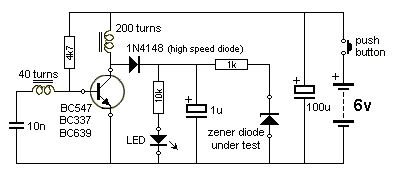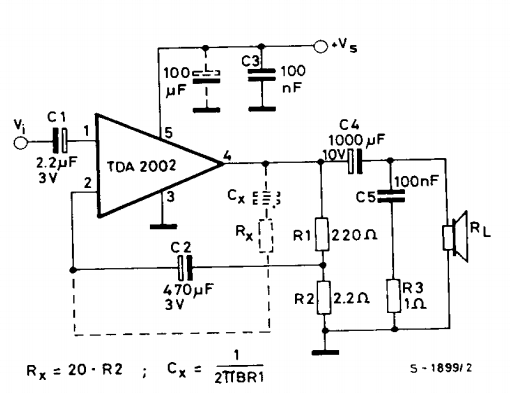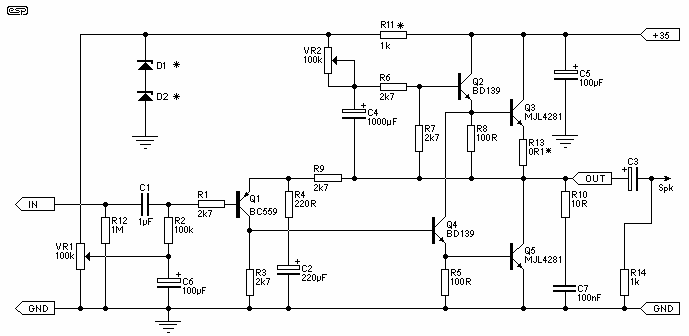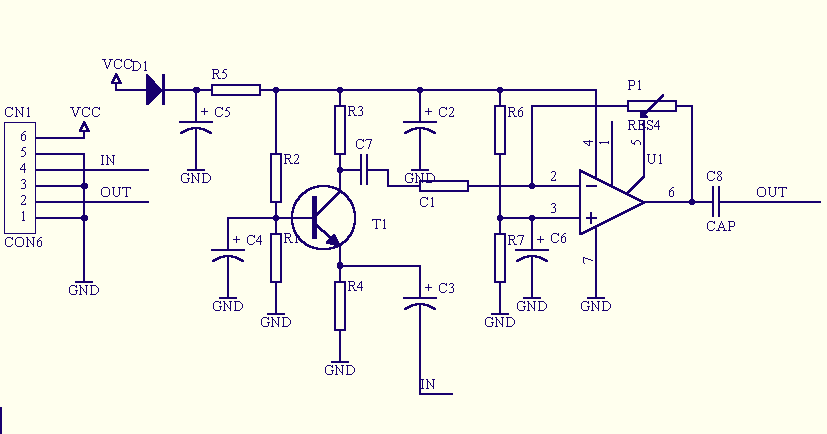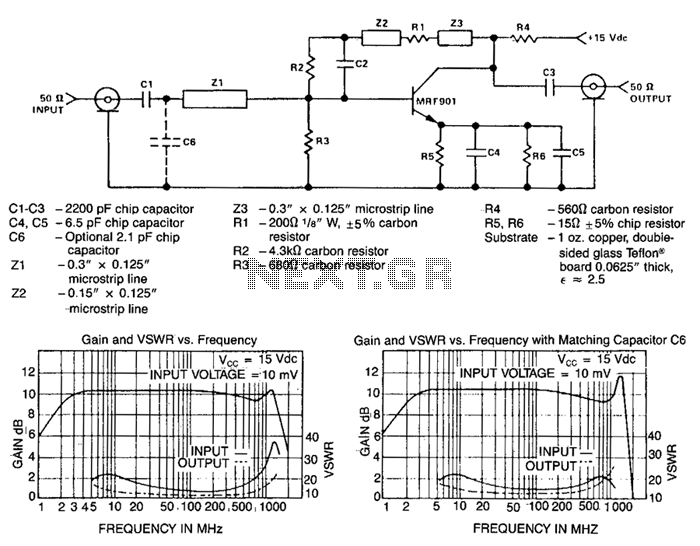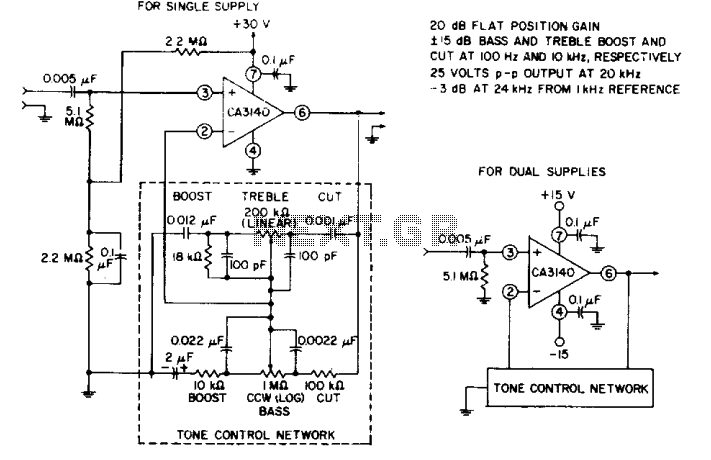
Spatial Distortion Reduction Headphone Amplifier

The objective of Linkwitz's article was to reduce distorted spatial reproduction when listening to recorded stereo music with headphones, addressing the "super stereo" effect where the music appears to originate from within one's head. To eliminate this spatial distortion, Linkwitz proposed that a small portion of a stereo channel's signal should be fed into the other channel. The article also presents arguments regarding the frequency contouring necessary for the required crossfeed. An addendum on the page describes software that implements the spatial distortion reduction scheme outlined on this site, which allows for the "digital remastering" of a RIFF/WAVE format selection from a music CD for headphone use. This software is particularly effective with portable high-capacity CD/MP3 players. Many musicians and sound engineers prefer headphones over speakers for their work, especially with the recent advancements in wireless RF and IR connected headphones that enhance mobility, although speakers are still favored for casual listening. A related project, the Direct Coupled Stereo Headphone Amplifier, eliminates output coupling capacitors and their associated issues while utilizing the surround sound techniques discussed here. At half wavelengths longer than the distance between the ears, the directional characteristics of speakers diminish, causing sound waves to diffract around the head, leading to a loss of stereo characteristics where each ear receives similar sound intensity from both speakers. To simulate the spatial environment of speakers at low frequencies using headphones, the strategy involves mixing both channels equally for frequencies below a certain threshold (Fl), effectively combining low frequencies from each channel in a monophonic manner. This approach allows the low-frequency listening environment of speakers to be approximated with headphones by crossfeeding nearly equal levels of the opposite channel's signal into the other channel, which can roughly double the sound intensity below Fl. While this is an approximation, it is reasonably close to values used in other designs, such as those by Jan Meier and Chu Moy, who employed 650 Hz and 700 Hz respectively in their crossfeed filters. The original Linkwitz paper also used 700 Hz. Assuming an omnidirectional polar response for hearing as a simplified approximation for high-frequency directional characteristics in an infinitely spatial room, Figure I illustrates a standard for stereo music listening with speakers positioned 30 degrees off-axis. As the head rotates clockwise to 30 degrees, sound intensity in the left ear increases to its maximum while sound intensity in the right ear drops to zero. The equations for sound intensity in the left ear from both speakers, as the head rotates, indicate that at zero degrees rotation (i.e., looking between the speakers), the combined sound in the left ear consists of 75% from the left speaker and 25% from the right speaker. Consequently, the high-frequency listening environment for speakers can also be approximated with headphones by crossfeeding approximately one-fourth of the opposite channel's signal into the other channel, thus maintaining a unity sound intensity.
The implementation of the crossfeed technique as described by Linkwitz requires careful consideration of the frequency response and the interaction between the channels. The process involves designing a filter that allows for the appropriate mixing of signals, ensuring that the crossfeed does not introduce additional distortion or phase issues. The filter should be designed to operate effectively at the specified cutoff frequencies, which are critical for maintaining the integrity of the audio signal while achieving the desired spatial effect.
In practical terms, the circuit design for a headphone amplifier utilizing the Linkwitz crossfeed technique would include operational amplifiers configured to mix the audio signals from both channels. The design would incorporate passive components, such as resistors and capacitors, to shape the frequency response of the crossfeed. The output stage of the amplifier must be capable of driving headphones efficiently, taking into account the impedance characteristics of the headphones being used.
Additionally, the design may include a user-adjustable control to vary the amount of crossfeed, allowing users to customize their listening experience based on personal preferences or specific audio content. This flexibility can enhance the overall effectiveness of the headphones in simulating a more natural listening environment, bridging the gap between headphone and speaker listening experiences.
Overall, the integration of Linkwitz's crossfeed concept into headphone amplifier design represents a significant advancement in audio engineering, providing listeners with a more immersive and spatially accurate reproduction of stereo music.The objective of Linkwitz` article was to reduce distorted spatial reproduction when listening to recorded stereo music with headphones-the "super stereo" effect where the music seems to be coming from inside one`s head. To remove the spatial distortion, Linkwitz reasoned that a small portion of a stereo channel`s signal should be fed into the other channel-and presented
arguments on the frequency contouring of the required crossfeed. There is a recent Addendum on this page that describes software that implements the spatial distortion reduction scheme outlined on this site-it allows a RIFF/WAVE format selection from a music CD to be "digitally re-mastered" for use with headphones. It works especially well with portable high capacity CD/MP3 players. There is a reason why many musicians and sound/recording/mixing engineers prefer headphones to speakers, (particularly with the recent releases of very good RF and IR connected headphones that remove the leash, ) except for casual listening.
(Note: there is a companion project, Direct Coupled Stereo Headphone Amplifier, that eliminates output coupling capacitors-and their related problems-and uses the surround sound techniques discussed here. ) At half wavelengths longer than the spacing spacing between the ears, directional characteristics of speakers are reduced, and the sound waves will diffract around the head; stereo characteristics can not be reproduced, and each ear will hear about the same sound intensity from either speaker.
The strategy to make headphones sound like speakers in a spatial environment at low frequencies is to mix both channels, equally, for frequencies below Fl, (e. g. , combine low frequencies from each channel in a monophonic fashion. ) This means that the low frequency listening environment for speakers can be approximated with headphones by crossfeeding about a factor of unity of the opposite channel`s signal into the other channel-about doubling the sound intensity below Fl.
Although this is an approximation, it is reasonably close to the value used in other designs-Jan Meier used 650 Hz. in An Enhanced-Bass Natural Crossfeed Filter, and Chu Moy used 700 Hz. in An Acoustic Simulator for Headphone Amplifiers. The original Linkwitz paper used 700 Hz. , also. Assuming an omnidirectional polar response for hearing as an approximation for high frequency directional characteristics in a room with infinite spatial dimensions, (admittedly, a simplistic assumption, ) Figure I, (which is available in larger size jpeg, PostScript, PDF, or xfig, formats, ) shows a standard for stereo music listening where the speakers are 30 degrees off axis.
As the head is rotated, clockwise, to 30 degrees, the sound intensity in the left ear increases to its maximum, (and the sound intensity in the right ear is zero. ) The equations for the sound intensity in the left ear from the left speaker, Ll, and the sound intensity in the left ear from the right speaker, Lr, as the head is rotated r degrees is: or the combined sound in the left ear, at zero degrees rotation, (ie.
, looking in between the speakers, ) would consist of 75% from the left speaker, and 25% from the right speaker. This means that the high frequency listening environment for speakers can be approximated with headphones by crossfeeding about a factor 1/4 of the opposite channel`s signal into the other channel, which is reduced by a factor of 1/4, such that it is still unity sound intensity.
Crossfeeding about a factor of unity of the opposite channel`s signal into the other channel for frequencies below Fl-about doubling the sound intensity below Fl, which is about 1100 Hz. Crossfeeding about a factor 1/4 of the opposite chan 🔗 External reference
The implementation of the crossfeed technique as described by Linkwitz requires careful consideration of the frequency response and the interaction between the channels. The process involves designing a filter that allows for the appropriate mixing of signals, ensuring that the crossfeed does not introduce additional distortion or phase issues. The filter should be designed to operate effectively at the specified cutoff frequencies, which are critical for maintaining the integrity of the audio signal while achieving the desired spatial effect.
In practical terms, the circuit design for a headphone amplifier utilizing the Linkwitz crossfeed technique would include operational amplifiers configured to mix the audio signals from both channels. The design would incorporate passive components, such as resistors and capacitors, to shape the frequency response of the crossfeed. The output stage of the amplifier must be capable of driving headphones efficiently, taking into account the impedance characteristics of the headphones being used.
Additionally, the design may include a user-adjustable control to vary the amount of crossfeed, allowing users to customize their listening experience based on personal preferences or specific audio content. This flexibility can enhance the overall effectiveness of the headphones in simulating a more natural listening environment, bridging the gap between headphone and speaker listening experiences.
Overall, the integration of Linkwitz's crossfeed concept into headphone amplifier design represents a significant advancement in audio engineering, providing listeners with a more immersive and spatially accurate reproduction of stereo music.The objective of Linkwitz` article was to reduce distorted spatial reproduction when listening to recorded stereo music with headphones-the "super stereo" effect where the music seems to be coming from inside one`s head. To remove the spatial distortion, Linkwitz reasoned that a small portion of a stereo channel`s signal should be fed into the other channel-and presented
arguments on the frequency contouring of the required crossfeed. There is a recent Addendum on this page that describes software that implements the spatial distortion reduction scheme outlined on this site-it allows a RIFF/WAVE format selection from a music CD to be "digitally re-mastered" for use with headphones. It works especially well with portable high capacity CD/MP3 players. There is a reason why many musicians and sound/recording/mixing engineers prefer headphones to speakers, (particularly with the recent releases of very good RF and IR connected headphones that remove the leash, ) except for casual listening.
(Note: there is a companion project, Direct Coupled Stereo Headphone Amplifier, that eliminates output coupling capacitors-and their related problems-and uses the surround sound techniques discussed here. ) At half wavelengths longer than the spacing spacing between the ears, directional characteristics of speakers are reduced, and the sound waves will diffract around the head; stereo characteristics can not be reproduced, and each ear will hear about the same sound intensity from either speaker.
The strategy to make headphones sound like speakers in a spatial environment at low frequencies is to mix both channels, equally, for frequencies below Fl, (e. g. , combine low frequencies from each channel in a monophonic fashion. ) This means that the low frequency listening environment for speakers can be approximated with headphones by crossfeeding about a factor of unity of the opposite channel`s signal into the other channel-about doubling the sound intensity below Fl.
Although this is an approximation, it is reasonably close to the value used in other designs-Jan Meier used 650 Hz. in An Enhanced-Bass Natural Crossfeed Filter, and Chu Moy used 700 Hz. in An Acoustic Simulator for Headphone Amplifiers. The original Linkwitz paper used 700 Hz. , also. Assuming an omnidirectional polar response for hearing as an approximation for high frequency directional characteristics in a room with infinite spatial dimensions, (admittedly, a simplistic assumption, ) Figure I, (which is available in larger size jpeg, PostScript, PDF, or xfig, formats, ) shows a standard for stereo music listening where the speakers are 30 degrees off axis.
As the head is rotated, clockwise, to 30 degrees, the sound intensity in the left ear increases to its maximum, (and the sound intensity in the right ear is zero. ) The equations for the sound intensity in the left ear from the left speaker, Ll, and the sound intensity in the left ear from the right speaker, Lr, as the head is rotated r degrees is: or the combined sound in the left ear, at zero degrees rotation, (ie.
, looking in between the speakers, ) would consist of 75% from the left speaker, and 25% from the right speaker. This means that the high frequency listening environment for speakers can be approximated with headphones by crossfeeding about a factor 1/4 of the opposite channel`s signal into the other channel, which is reduced by a factor of 1/4, such that it is still unity sound intensity.
Crossfeeding about a factor of unity of the opposite channel`s signal into the other channel for frequencies below Fl-about doubling the sound intensity below Fl, which is about 1100 Hz. Crossfeeding about a factor 1/4 of the opposite chan 🔗 External reference
